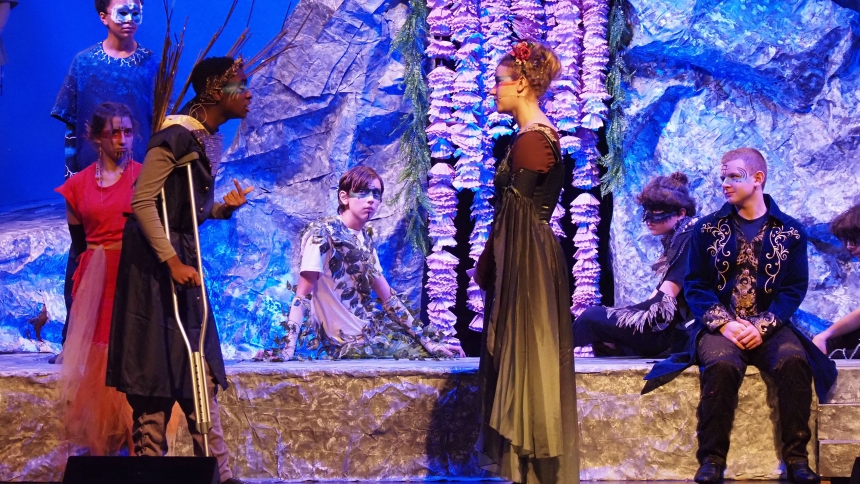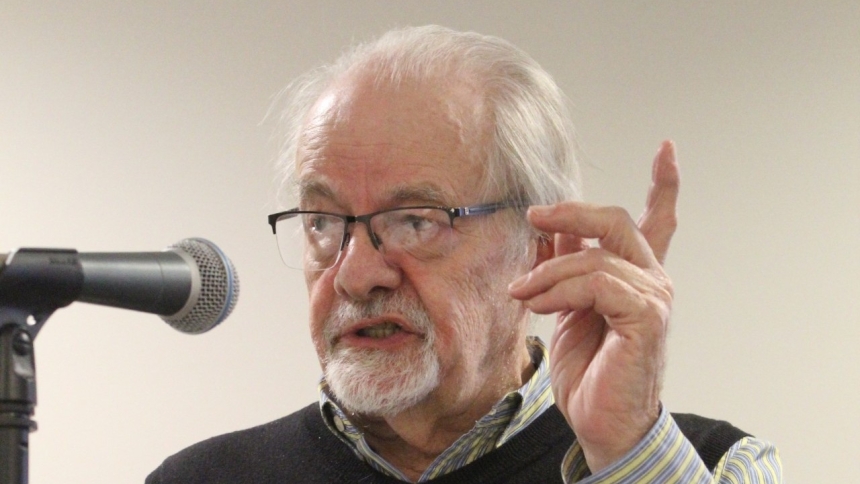
MICHIGAN CITY – “God trusts you to be His ambassadors,” Father David Kime told a group gathered for his talk on religious orders.
The presentation by the pastor was part of the Queen of All Saints Tapped In series held on Wednesday nights throughout October at Gelsosomo’s Pizzeria in Michigan City. Nearly 75 people attended each evening.
Father Zachary Glick kicked off the month-long series on Oct. 2 with his talk on Liturgical Rites which was followed by Father Kime’s talk. Father Gregory Bim-Merle spoke on Oct.16 about Catholic organizations. The series concluded on Oct. 23 with Deacon Bill Zientarski’s discussion on "What is a deacon?"
Although the majority of Father Kime’s conversation centered on the development of religious orders, the talk came full circle as he finished where he began, with a focus on the laity.
“Your job is to find sanctity in your everyday life – the ministry of your family, washing dishes, going to your law firm, as a nurse, garbageman, teacher, whatever you do – and in that ministry to promote the Gospel of Jesus Christ.
During the Church’s early years, which had no religious communities, the laity played a major role in spreading Christ’s message, which often came with a great price, according to Father Kime.
“The Church was directed by the apostolic zeal by people like you. The laity were the movers and shakers, evangelizing and changing the world by individual relationships with people that they knew,” he said.
Christians faced persecution, and even death, for their beliefs until 313 A.D., when Roman emperor Constantine legalized Christianity following his conversion. A wave of baptisms soon followed, but Father Kime shared, a number of them were for the wrong reason. He explained that with the emperor now a Christian, if someone wanted to get ahead, be influential, or “have the emperor’s ear,” they too would need to be Christian.
“The Church lost this apostolic zeal. Many people became Christian but not necessarily for the right reason. It lost its pure experience of the Christian faith after it became the religion of the empire. The people who joined in 190 were willing to die. Those who joined in 390 joined so that they could have a very good life,” remarked Father Kime.
A movement began by those who desired an old world, pure religion, one they were willing to die for.
Those in the early movement took their spirituality to new heights. According to Father Kime, the Stylite, or pillar, saints, would locate a large pillar, which could be as tall as 30-50 feet in height, and place a three-foot by four-foot platform on top for them to reside for the rest of their lives. People would send food up, while they would preach and offer prayers for those on the ground.
The Stylite movement didn’t last long and was quickly followed by the Desert Fathers, who left behind villages and towns. They became hermits, residing in caves or huts.
“They lived a true, pure form of Christianity. They fasted, sacrificed, and prayed in order to experience the early Christian faith, that involved some measure of suffering and dying to self,” said Father Kime.
The monastic movement began to grow over time. As the orders grew, rules on how to live together were formulated and formalized.
Then, in 476, with the fall of Rome, everything was falling apart, society had collapsed, and people were in danger of invasion by barbarians; people were looking for stability. “There was only one group, one institution that existed at this time that could fill the demand society needed to have some level of order – the Church,” explained Father Kime. “They stepped in to give some order in the midst of chaos. They organized defense for the cities, helped the sick, organized education – every aspect of human life.”
With the monasteries came advancements in medicine, philosophy, agriculture, education, and science.
A second phase of monastic life began in around 1100 - 1200 with the Mendicant Orders, which included the Franciscan and Dominican communities.
“They answered a different need of the Church. The Mendicant Orders are specifically for preaching, not hiding behind the walls of the monastery. They go out and proclaim the Gospel while living the beauty of community life,” explained Father Kime.
The “Golden Age” of religious communities began in the late 1600’s and ended in the mid-1900’s. “Wherever there was a need in the Church, a new religious community was founded. There was an explosion of religious communities all over the place,” said Father Kime. Once the needs were met, many of the communities died off.
He concluded his talk with a sense of urgency to those in the crowd, as well as the laity in general.
“The next movement in the Church isn’t a religious movement. What we need now is to return to the apostolic mission of the first 300 years of the Church, where every lay man and woman believe in the sanctity of their life and use their life in order to proclaim the Gospel to their family and friends,” said Father Kime.
He emphasized the need for religious orders, and the two working together in unison.
“We are in the springtime of Christianity. You must begin now – to live the sanctity of your laity. Stop relying on institutions to do your work. You must do the work of evangelization,” he said. “You are the Church. When we become the evangelizing force that we really are, this world better watch out because our Christian faith is powerful, it is beautiful.”
The view the any of the talks, go online to youtube.com/@tappedinqueenofallsaints3505
Caption: Father David Kime, pastor of Queen of All Saints and St. Mary the Immaculate Conception, takes questions following his talk on religious order during QAS’s Tapped In evening at Gelsosomo’s Pizzeria on Oct. 9. (Deacon Bob Wellinski photo)



